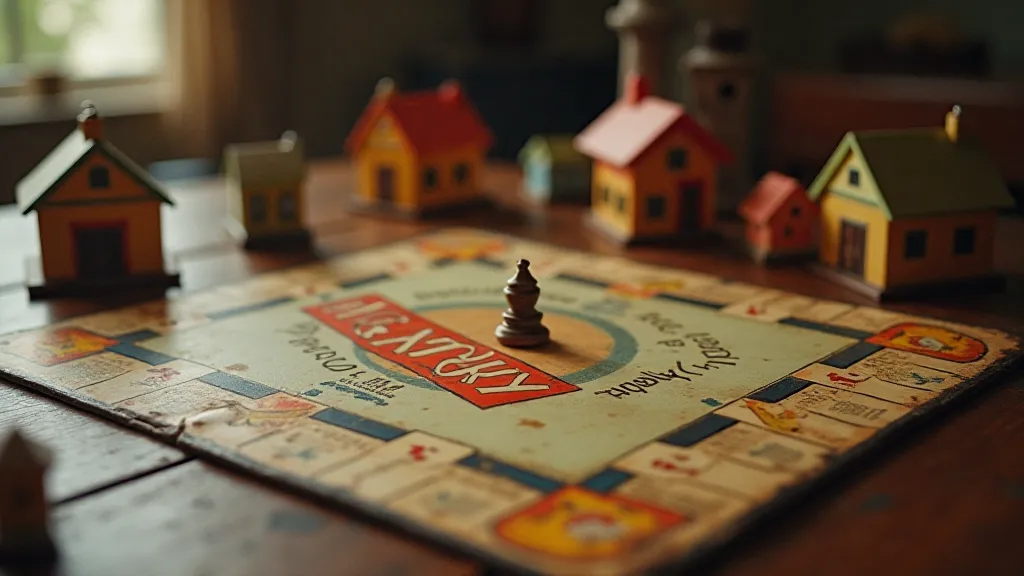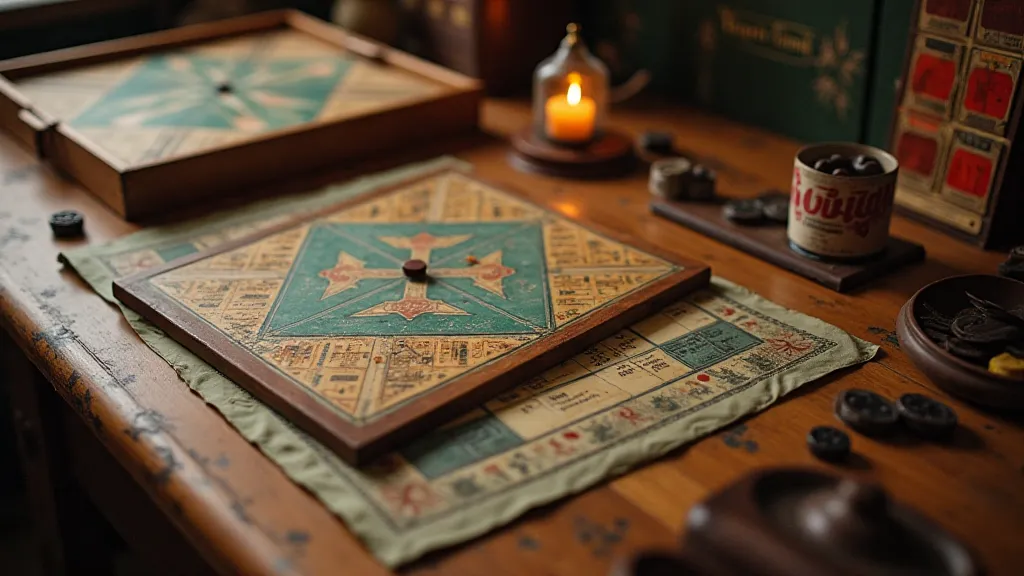Echoes in the Polyhedral Dice: Tracing Lineage in Tabletop Game Design
There's a peculiar resonance that lingers when you hold an antique accordion. Not just the mechanical hum of bellows and reeds, but something deeper – a sense of hands crafting something beautiful, a feeling of music whispering across decades. It’s similar, I think, to holding a vintage board game. Many modern games feel immediate, disposable almost. But older games… they possess a weight, a history, a tangible connection to the minds who conceived them, and the players who cherished them.
We talk a lot about innovation in board game design, and rightly so. The field is constantly evolving, pushing boundaries and experimenting with new experiences. But rarely do we truly acknowledge the long, interwoven lineage upon which these innovations are built. Modern games don't spring from a vacuum; they're echoes of past triumphs, adaptations of enduring concepts, and quiet nods to pioneers who sometimes faded from collective memory. It's fascinating to consider the intricate, sometimes invisible, connections that link seemingly disparate games across generations – a concept explored more deeply in articles like The Archivist's Vault: Cataloging the Ephemera of Forgotten Gaming Experiences.
The Foundation: Chaturanga and the Dawn of Strategy
Let’s rewind, far beyond Monopoly and Clue. The very roots of tabletop gaming trace back to 6th century India with Chaturanga. Often cited as the ancestor of chess, Chaturanga included elements of strategy, chance (dice determined movement), and even rudimentary military tactics. While its rules were vastly different, the core concept of representing conflict on a defined space – maneuvering forces, planning attacks, and anticipating your opponent's moves – is a blueprint that resonates across millennia.
Consider Hnefatafl, a Norse strategy game dating back to the 8th century. Like Chaturanga, it involves asymmetrical forces and a focus on strategic positioning. The Viking attackers attempt to surround and capture the lone defender, a dynamic that evokes feelings of vulnerability and tense pursuit. The spatial reasoning and planning required in both games are elemental components that appear again and again in later games, even in surprisingly modern iterations.

The Victorian Era: A Flourishing of Family Diversions
Jumping forward to the Victorian era, we find a fertile ground for the development of increasingly complex games. The rise of the middle class and increased leisure time led to a surge in popularity for family entertainment. Games like Tiddlywinks, a seemingly frivolous game of flicking small counters, offered a surprisingly intricate strategic depth. The game's appeal lies not just in its simple premise but in the sheer number of potential tactics and subtle ways to manipulate the board. This era’s dedication to detail extended to storytelling - a nascent appreciation for how seemingly simple mechanics could contribute to a larger narrative landscape. To truly understand how narratives developed in tabletop games, consider exploring “The Dream Weaver’s Loom: How Narrative Threads Unravel in Forgotten Games," which delves into the subtle emergence of storytelling in historical games.
Then there's The Mansion of Bright, a delightfully absurd game from 1886, where players navigate a maze-like mansion collecting jewels and avoiding goblins. The game's charm stems from its whimsical artwork and humorous challenges – a stark contrast to the often grim and militaristic themes of earlier games. It laid groundwork for future games with randomized elements and character-driven narratives, long before those became commonplace. This foreshadows how even the simplest rulesets can, in their own way, shape the broader landscape of game design; a perspective further explored within The Ephemeral Kingdom: How Rulebooks Define and Limit Board Game Universes.
These Victorian games were often marvels of craftsmanship. The boards were meticulously inlaid with intricate patterns; the pieces were carved from high-quality wood or crafted from durable materials. The care and attention to detail reflected a commitment to creating lasting heirlooms – objects meant to be passed down through generations. It’s a level of quality and artistry that’s often lost in today’s mass-produced game market.
The 20th Century: From Deduction to Adventure
The 20th century witnessed an explosion of game design, often building upon the foundations laid down by earlier generations. Clue (originally Murder!) elegantly refined the deduction game, creating a formula that would be endlessly imitated. But even Clue’s mechanics have precursors. Think about earlier games that involved gathering clues and making inferences – the concept isn't entirely novel; Clue simply presented it in a more accessible and engaging package.
Monopoly, often derided for its potential to breed frustration, owes a surprising amount to The Landlord’s Game, a game created by Lizzie Magie in 1903 to demonstrate the economic consequences of unchecked monopolies. While Monopoly stripped away much of Magie’s original intention, it inherited the core mechanic of buying and selling properties, a principle that has resonated across countless property-trading games ever since. The history of games is not always one of straightforward progress, and the narratives behind their creation can be deeply complex – sometimes revealing uncomfortable truths about cultural shifts and economic influences. Examining these failures, and the lessons learned from them, is vital to understanding the evolution of the hobby; a topic critically discussed in The Rusting Monolith: Deconstructing the Failures and Lessons from Discarded Games.

Beyond Mechanics: The Narrative Threads
It's tempting to focus solely on the mechanical innovations that define board games. However, the narrative scaffolding – the story, theme, and player agency – is equally vital. Games like The Mansion of Bright, with its whimsical narrative, demonstrate how even seemingly simple mechanics can be infused with a rich storytelling experience. Similarly, the economic themes explored within games like The Landlord’s Game, though often obscured in subsequent iterations, represent an early attempt to engage players with complex societal issues. Examining how components themselves contributed to these developing narratives is a fascinating pursuit, and “The Stone Mason’s Legacy: Etching the History of Board Game Components,” explores precisely that subject.
This integration of mechanics and narrative is an ongoing challenge for game designers. How can we create games that are both strategically engaging and thematically resonant? How can we empower players to shape the narrative through their choices? These questions require a nuanced understanding of both game design principles and storytelling techniques. The relationship between gameplay and narrative isn't always obvious, and deciphering the underlying structure of seemingly abstract games can be a rewarding endeavor; as highlighted in The Storyteller’s Bones: Analyzing the Narrative Scaffolding of Abstract Board Games.
Preserving the Legacy: Restoration and Appreciation
Restoring an antique game isn't just about fixing broken pieces; it's about preserving a piece of gaming history. The process often involves carefully cleaning and repairing the board, replacing missing pieces, and researching the game's origins and rules. It’s a deeply rewarding experience, connecting you to the players who enjoyed the game decades ago, and reminding you of the ingenuity and creativity of early game designers.
Collecting these forgotten games isn't about amassing a fortune; it's about appreciating the craftsmanship, the history, and the enduring appeal of tabletop gaming. It’s about recognizing that innovation doesn't occur in a vacuum; it’s a conversation across time, a continuous evolution of ideas, and a testament to the power of play. There's a quiet beauty in holding a game that has survived generations – a tangible link to the past that reminds us of the enduring human desire to connect, compete, and create.

The echoes of these forgotten games resonate in the games we play today. By understanding their lineage, we gain a deeper appreciation for the art of game design and a renewed respect for the pioneers who paved the way for the modern tabletop gaming landscape. Consider the subtle influences of Victorian-era games on contemporary designs, or the lasting legacy of early deduction games on modern mystery-solving experiences. The narrative threads woven through these older games are as significant as the mechanical innovations, and offer compelling insights into the evolution of player interaction and engagement. Examining the materials used in these forgotten games, and how they shaped the gaming experience, can offer a unique perspective on the history of tabletop design. The way board game components evolved to not only function but also enhance the immersive quality of gameplay is a significant part of this historical journey.
The continuous cycle of inspiration and adaptation, where designers draw from the past to create the games of the future, ensures that the legacy of these pioneering games will continue to resonate for generations to come. Understanding this continuous thread helps to paint a comprehensive picture of how tabletop gaming, as a pastime and an art form, has reached the place it occupies today. It reminds us that the seemingly simple act of moving pieces across a board is, in reality, a rich tapestry of human creativity, ingenuity, and a timeless desire for connection and play.





